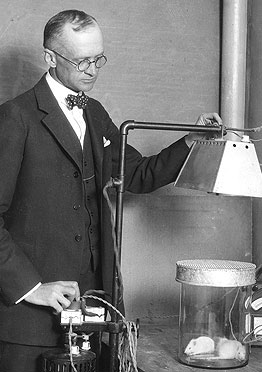Harry Steenbock facts for kids
Harry Steenbock (born August 16, 1886, in Charlestown, Wisconsin; died December 25, 1967, in Madison, Wisconsin) was a smart scientist. He became a professor of Biochemistry at the University of Wisconsin–Madison. Steenbock finished his studies at Wisconsin in 1916.
Discovering Vitamin D
Harry Steenbock grew up on a farm in Wisconsin. He studied at the University of Wisconsin–Madison. During his time there, he helped with important experiments. These experiments looked at how different foods affected animals.
In 1923, Steenbock made a huge discovery. He found that shining ultraviolet light on foods could add vitamin D to them. He tested this by shining light on rodent food. He then fed this food to rodents that had rickets. Rickets is a disease that makes bones weak. Steenbock saw that the rodents got better! This showed that vitamin D could cure rickets. We now know that not having enough vitamin D causes rickets.
Steenbock used his own money to get a patent for his discovery. A patent protects an invention so others can't copy it easily. His method of adding vitamin D to food was used for many products. It was especially used for milk. By 1945, when his patent ended, rickets had almost disappeared.
Helping Science Grow: WARF
After his patent, a company called Quaker Oats offered Steenbock a lot of money. They wanted to buy the rights to his vitamin D technology. But Steenbock had a different idea. He thought the money should go back to the university. He wanted it to help other scientists and new discoveries.
Steenbock talked to nine other people who had studied at the University of Wisconsin–Madison. Together, they started something new. It was the first university office to help turn new ideas into useful products. This office was called the Wisconsin Alumni Research Foundation (WARF). WARF started with $900, with each person giving $100.
On February 19, 1927, WARF made its first deal with Quaker Oats. This deal allowed Quaker Oats to add vitamin D to their breakfast cereals. WARF also let medicine companies use the technology. This led to a medicine called Viosterol, which helped people get enough vitamin D.
The Steenbock Memorial Library at the University of Wisconsin–Madison is named after him. It honors his amazing contributions to science.


